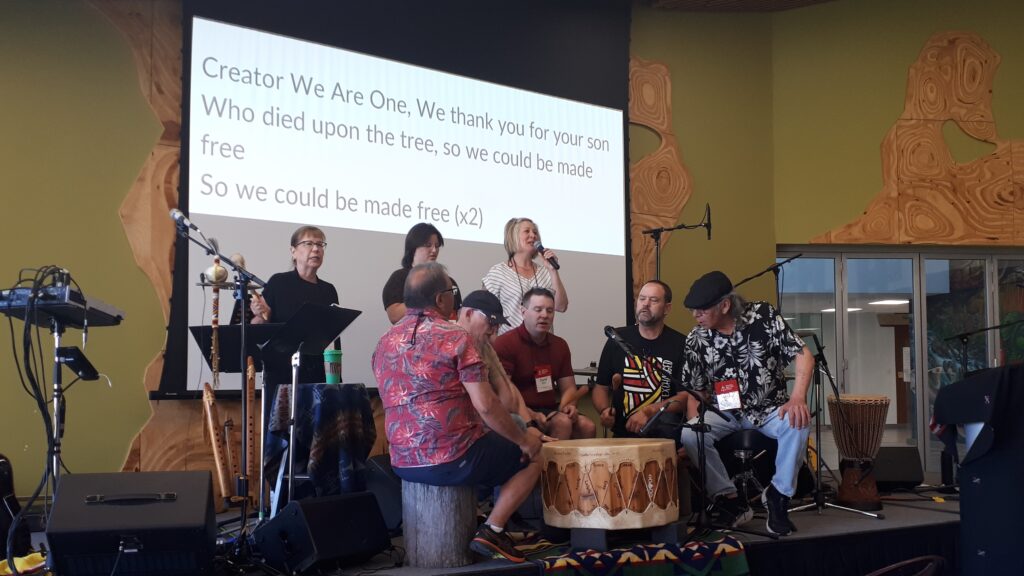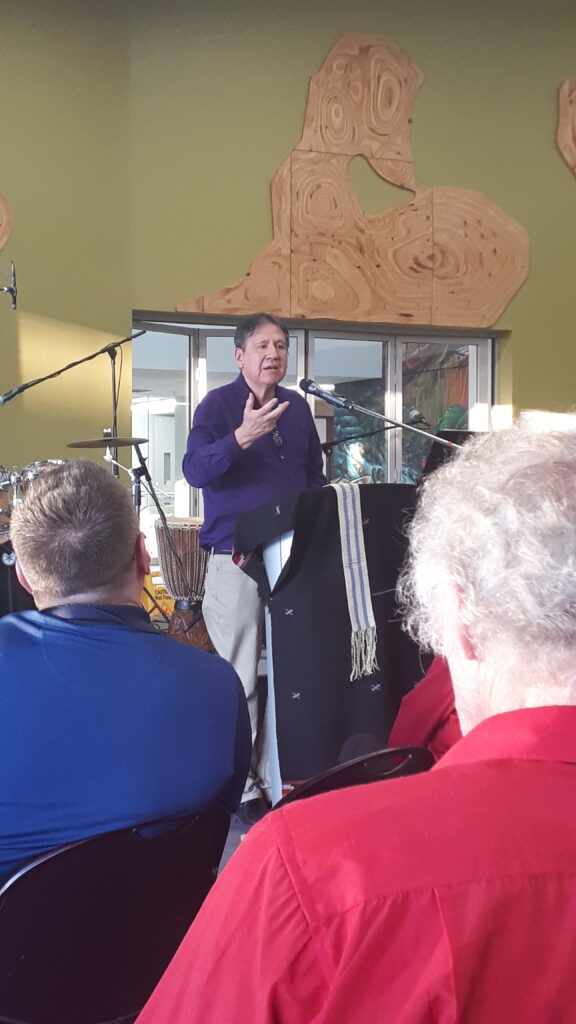
The Road to Reconciliation Begins with Justice
Featured Image: The Gathering’s praise team leading in “Creator We are One”.
This was the message shared by Adrian Jacobs, Senior Leader for Indigenous Justice and Reconciliation, at the recent Canadian National Gathering. “People sometimes want to jump right to reconciliation,” Jacobs shared, “but there is a stop before you get there, and it is called justice. It is not something that can be skipped.”
Over 150 people from across Canada gathered to listen and exchange hearts with Indigenous brothers and sisters and to see a new way forward in their homes, churches, and communities. The Gathering was held May 25-28, 2023, at the Algonquin College Ottawa Campus in Ontario. Most attendees were either nominated or appointed by their local Classis and many had already been a part of the Hearts Exchanged learning cohorts over the past two years.
Indigenous ministry is not new to the CRC. Jacobs reminded attendees of the covenant commitment to the Indigenous people, signed by the CRC Executive Director along with the Council of Christian Reformed Churches in Canada, back in 1987. More recently, the CRCNA signed on to the commitments of the Truth and Reconciliation Commission of Canada in 2015. Most notably is the current CRC Indigenous Ministry, made up of a national committee (Canadian Indigenous Ministry Committee, CIMC), three Urban Indigenous Ministries, and the hiring of Jacobs. Each of these initiatives works together to support healing and reconciliation between Indigenous peoples and non-Indigenous people in Canada.
As well, at the previous Canadian National Gathering at The King’s University in Edmonton, Alberta, in 2019, it was stated loud and clear: Canadian CRC members wanted to gather around the themes of faith, justice, and reconciliation. As news stories of unmarked and forgotten graves at residential schools came to light in the summer of 2021, the need for this became even clearer.
This year’s 4-day gathering included times of worship, plenary talks, breakout sessions (with the option to do a “Sacred Pause”), and plenty of networking time with various CRC agencies and attendees over meals and at break times. Intentional listening circles were also integrated into the weekend; an opportunity for regional groups to share what they were hearing and learning and to begin to answer the “what now?” for when they return to their home churches and communities. For anyone attending, and particularly for those who hadn’t done Hearts Exchanged previously, a set of pre-learning activities provided by the planning team also helped prepare hearts and minds for the gathering.
“My key takeaway from the weekend is to keep listening, with an open heart, even when it’s uncomfortable,” shared Karla Winham, staff member of Diaconal Ministries. “It doesn’t always feel like enough but I think until we let these stories of oppression and trauma really sink in, we aren’t in the right place to take the lead on doing things anyway. I think of listening as preparing the soil, so that we can join in on the Indigenous-led actions happening around us – but I’m not sure the seeds are ours to plant. Listening makes us aware of opportunities and more able to build those trusting relationships.”
Rev. Dr. Raymond Aldred, director of the Indigenous Studies Program at the Vancouver School of Theology and one of the main plenary speakers, echoed Winham’s words. “If you do not learn to listen and feel the pain that you have caused, then you cannot be transformed. That [other person] gives you a gift when they tell you how much your actions hurt them. Unless you feel, you will not have the emotional resources to change. But it is not easy, so you have to learn to listen.”
Mary Blydorp, a deacon in Central Ontario and current Board Member of Diaconal Ministries, heard a strong desire to connect – to “exchange hearts” with our Indigenous brothers and sisters – and to be Christians on this journey together. “I felt the Spirit at work in the midst of broken people looking to connect and love each other. The breakouts and meal times provided a venue for much discussion and interaction with different people.” Something many seemed to be longing for, Blydorp added.
“I wanted to attend this gathering because I HAVE been listening for a while,” Winham added. “It doesn’t mean I know everything, but it means I was open to the invitation and ready to learn more. And I plan to keep taking steps as the opportunities arise. I hope for me and others who attended that this won’t just be a “mountaintop moment” that makes no difference in how I show up in life. I hope that I can articulate what I’ve learned to other people who need to hear it.”
To meet on the level of exchanging hearts is where the gospel lives, Aldred reminded the group. “This is where Jesus is found. Not on the level of the mind or of religious institutional purity, but on the level where humans live their real lives – the level of human suffering, the level of the heart.”
It is all about reconciliation and living in right relationship with each other, which is what Jesus calls us to, Jacobs shared. Part of that is remembering the covenants (the promises) that were made – primarily through treaties – years ago. Treaties that still matter today.

“I am telling you right now that some of the suffering that is happening right now in this place and in this world is because of broken covenants,” Jacobs shared.
Jacobs said that he sees Jesus and the gospel message in the Two Row Wampum, part of his opening talk on the Friday morning. When the Haudenosaunee people met the Dutch in 1613 near the Mohawk and Hudson rivers in upstate New York, a covenant was made between the two peoples, represented by the Two Row wampum belt. This was to be a physical representation of the relationship between these two very different groups. This covenant was continually renewed in another wampum belt, the Silver Covenant Chain, where the silver of the three links of this chain – that tarnish over time – were polished bright once again. Part of this national gathering, Jacobs said, was each of us coming together once again to ‘polish the silver’ of this covenant agreement and bring us back to the early friendship that was forged 400 years ago.
This is what justice looks like; justice that then lays the groundwork for reconciliation between all peoples of this country. Then, and only then, can we move forward together. (Watch a video from a recent storytelling event that Jacobs led about the Two Row Wampum belt HERE.)
“I’m not just a new kid on the block with a new message. I am in a long line of people going back to 410 years ago,” Jacobs said. “I’m saying the same things my ancestors have said. I’m here to say that things could have been different. Let’s make it that way.”
Sign Up for Hearts Exchanged!
Are you longing to connect with your Indigenous neighbours? Are you ready to listen and engage heart-to-heart with them and hear their stories? Are you struggling with where to start? New Hearts Exchanged cohorts are being formed for this coming Fall. Find out more HERE.
You can also visit the CRC Indigenous Ministry website and find more resources HERE.



